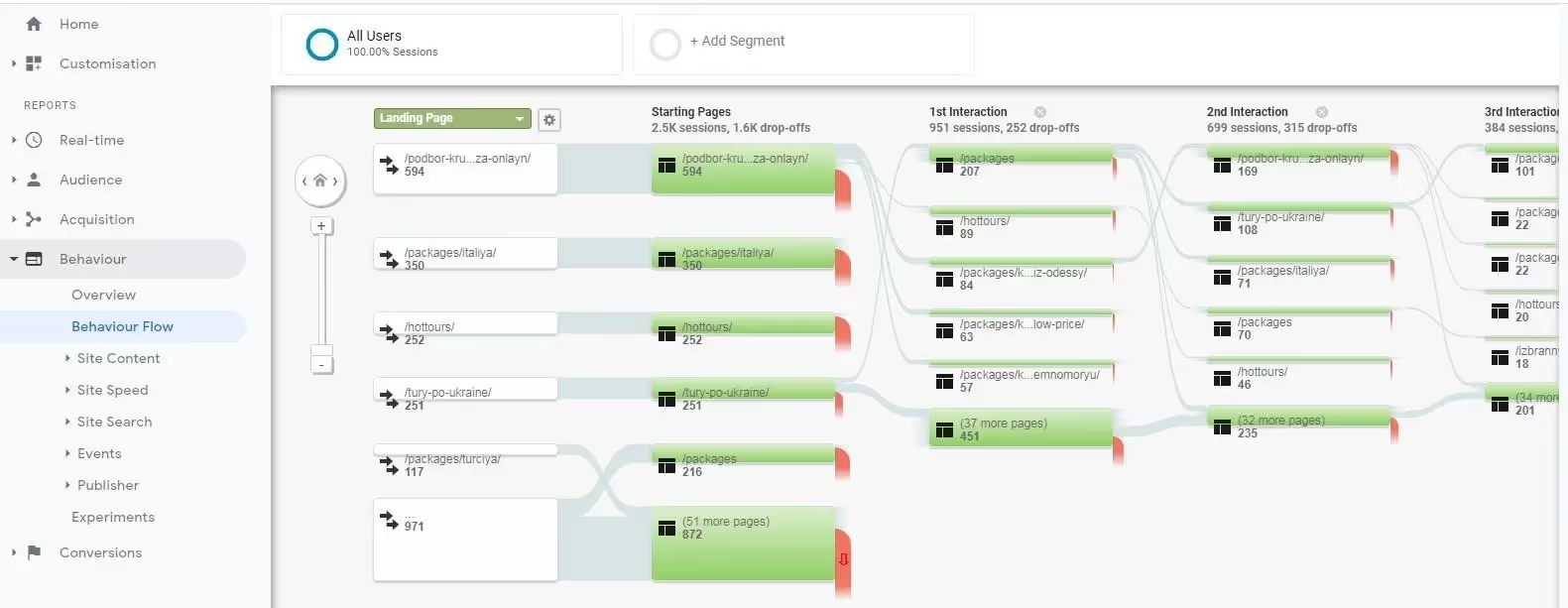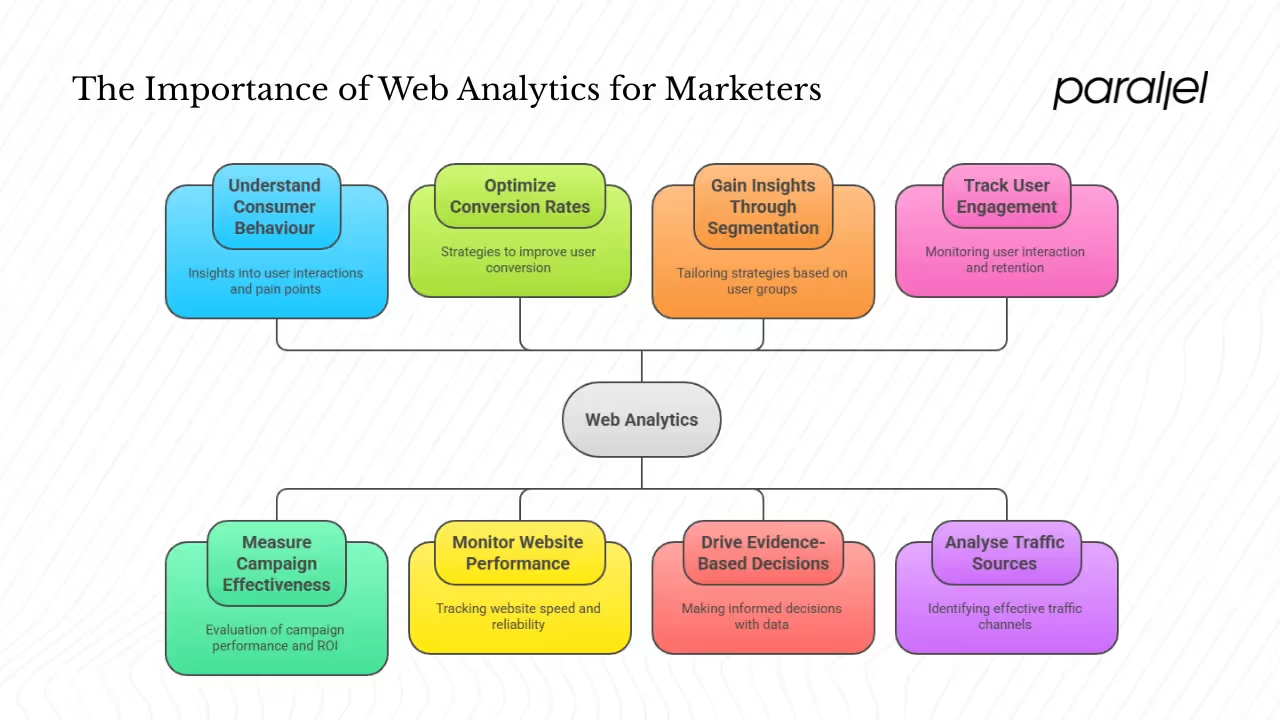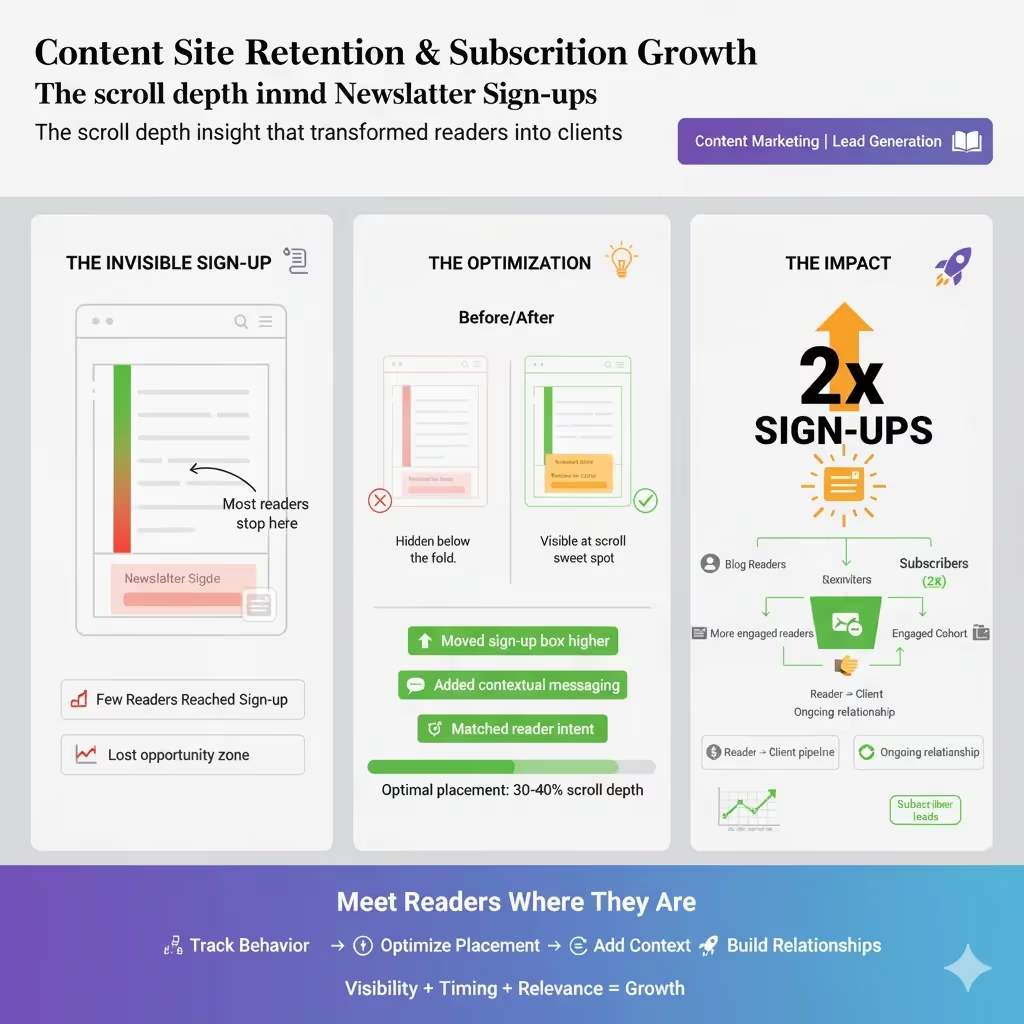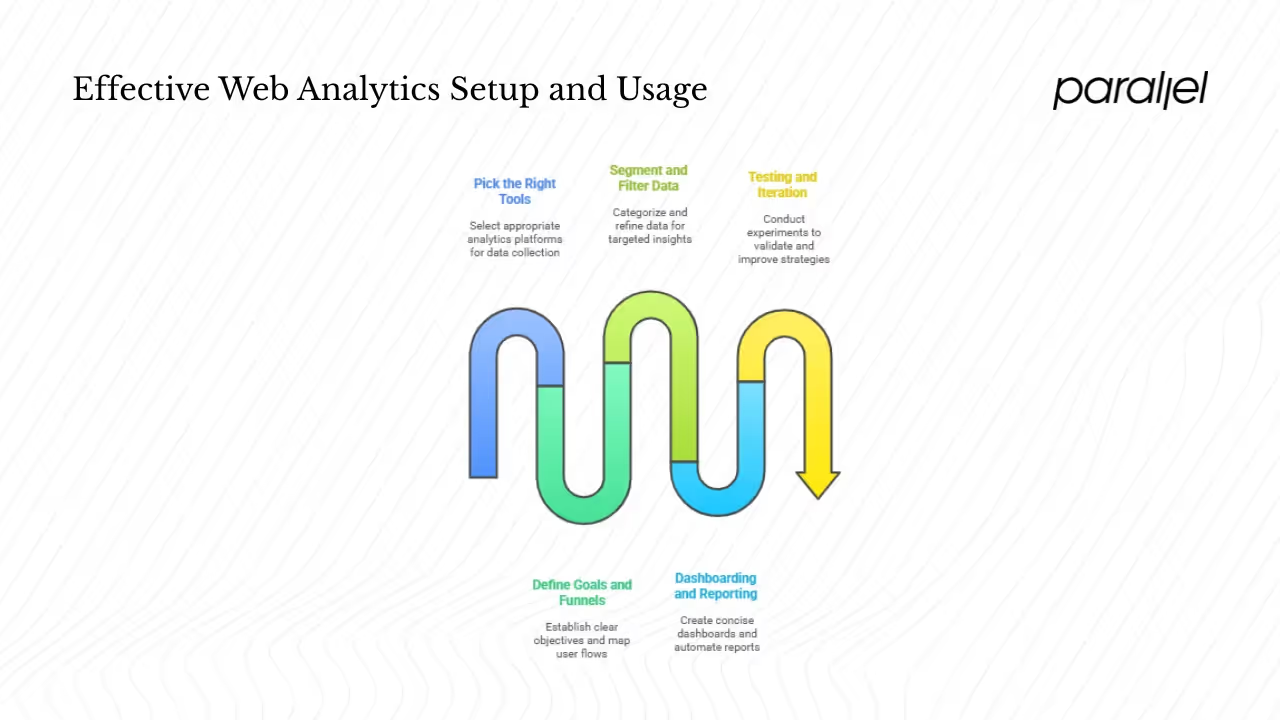Why Are Web Analytics Important to Marketers? Guide (2026)
Discover why web analytics are essential for marketers, enabling data‑driven decisions that improve campaigns, engagement, and conversions.

A small subscription software company I worked with had a beautifully crafted site but poor trial sign‑ups. Instrumenting the signup flow showed that 60% of prospects abandoned one confusing screen; redesigning it lifted conversions by 30%. If you’ve ever asked yourself why web analytics are important to marketers, this story shows why: you can’t improve what you don’t measure. In this article I’ll explain what web analytics covers, why marketers should care, how to pick the right tools, and how to put insights into action.
What are web analytics?
Web analytics is the practice of collecting, measuring, and interpreting information about how people use your site. A good analytics setup tracks everything from page views and sessions to events like clicks, submission steps and purchases. It also includes presenting the data in dashboards or visualizations so that teams can quickly see patterns and make decisions. Put simply, web analytics gives you the evidence behind user behaviour.

Quantitative and qualitative data
Most systems collect quantitative data such as sessions, page views and conversions. This data tells you what happened but not why. Behaviour tools fill that gap by capturing qualitative signals — such as heatmaps, scroll depth and session recordings — so you can see what users looked at, clicked, or skipped. When used together, these two kinds of data help you make informed decisions rather than guesses.
How tools gather data
Tracking works via small JavaScript tags that send hits to analytics servers and identify sessions. Events log clicks, registration steps and video plays, and integrations link marketing spend to on‑site actions. With third‑party cookies fading and regulations like the GDPR requiring consent, first‑party tagging has become essential.
Core metrics and KPIs
A useful analytics framework begins with clear definitions:
- Traffic metrics: sessions, users, page views, new vs returning visitors, and traffic sources. These values show how many people you attract and where they come from.
- Engagement metrics: bounce rate, exit rate, time on page, scroll depth and pages per session. High exit or bounce rates often signal friction.
- Conversion metrics: goals, events, funnels and conversion rate. These metrics reveal how many users take a desired action such as signing up or completing checkout.
- Behaviour metrics: path flows, exit pages and drop‑off points. These help you see where people get lost or frustrated.
- Segmented metrics: slices of data by device type, geography, channel or cohort. Segmenting helps you discover which audiences perform differently.
How web analytics relate to marketing
For marketers, analytics is not just a technical task. It is the backbone of campaign measurement, allowing you to track how each channel contributes to traffic and conversions.
Tools integrate with paid media platforms, search‑engine optimization, content management systems and email marketing so you can view the full picture. By combining on‑site engagement data with acquisition metrics, you can analyse whether a paid ad or blog post attracted the right audience and whether those visitors converted or bounced. That’s why web analytics is at the core of modern marketing.
Why web analytics matter for marketers

1) Understand consumer behaviour
When you look at analytics, you’re not just looking at numbers; you’re looking at people trying to accomplish something. Session recordings and heatmaps expose where users click, scroll or get stuck. If drop‑offs spike at a particular step of a signup flow, that’s a hint that wording or layout is confusing. According to Contentsquare’s research, companies that combine web analytics with behaviour tools can see exactly where visitors are engaged and where they struggle. As marketers, this understanding allows you to improve products and campaigns instead of guessing.
2) Measure campaign effectiveness
Attribution remains one of the hardest problems in marketing. With proper tagging, you can see whether search, social, email or paid ads drive meaningful traffic. HubSpot’s 2025 marketing statistics show that websites, blogs and search engine optimization were the top channels generating return on investment for B2B brands in 2024. Without analytics, you won’t know which campaigns deserve more budget or which should be paused. A/B testing is another critical practice: by measuring variant performance, you can quantify the impact of a headline, image or call‑to‑action rather than relying on personal preference. This ability to measure impact is central to why web analytics are important to marketers.
3) Optimize conversion rates
Conversion Rate Optimization (CRO) isn’t about changing buttons at random; it’s about diagnosing bottlenecks, testing hypotheses and quantifying improvement. Web analytics tools show where users abandon flows, while behaviour tools reveal the cause. More than one‑third of marketing leaders say conversion rates are a top KPI, yet nearly two‑thirds report that their landing pages convert at under 10%. By focusing on steps with the highest drop‑offs, running experiments and measuring uplift, you can improve conversion rates in a disciplined way. This is another example of why web analytics are important to marketers.
4) Monitor website performance
Speed and reliability are now table stakes. Long load times increase bounce rates and hurt search rankings. Analytics platforms report page load times, responsiveness and differences between mobile and desktop. By correlating performance metrics with engagement or drop‑offs, you can identify technical issues that cause users to leave. For instance, if slow pages show a bounce rate above the site average, you have a clear optimisation priority.
5) Gain insights through segmentation
Not all visitors behave the same. Segmenting by channel, device or geography reveals patterns you would otherwise miss and helps refine your messaging for different groups.
6) Drive evidence‑based decisions
Decisions grounded in data are more persuasive. Dashboards turn metrics into simple stories and reduce the hours spent compiling unread reports. Visualising only the metrics that matter helps teams prioritise initiatives based on impact versus effort.
7) Track user engagement
Metrics like scroll depth, repeat visits and time on site show how deeply users engage. These signals can predict retention or churn and provide early warnings when engagement drops.
8) Analyse traffic sources
Compare sources (organic, paid, referral and social) to see which deliver quality visitors. Average eCommerce conversion rates are under 2%, so you need to know which channels produce paying customers and which drive vanity traffic. Asking why web analytics are important to marketers becomes easy when you can see which sources produce paying customers.
Practical use cases and examples
SaaS onboarding improvements
For a productivity tool we worked with, nearly half of prospects abandoned the registration process. Instrumenting each step revealed friction at account verification. Simplifying copy and fields lifted the signup rate from 8% to 12% and added recurring revenue. Data shows you where to act.

eCommerce checkout optimisation
At a retail client, heatmaps revealed that a promotional banner distracted shoppers from the checkout button. Moving the banner and emphasising the call‑to‑action reduced basket abandonment from 70% to 55%, mirroring a public example where similar adjustments drove extra revenue. Without analytics, you wouldn’t know where customers get distracted, which is why web analytics are important to marketers.

Content site retention and subscription growth
On our own blog, scroll data showed that few readers reached the newsletter prompt. Moving the sign‑up box higher and contextualising it doubled sign‑ups and led to a cohort of engaged readers who later became clients.

These examples illustrate the practical power of analytics. They also prove the value of analytics by showing that insights translate directly into revenue and growth.
How to set up and use web analytics effectively

1) Picking the right tools
Use both quantitative and behavioural analytics tools. Platforms like Google Analytics and Adobe Analytics provide metrics and dashboards, while Hotjar, FullStory and Smartlook let you watch sessions, see heatmaps and capture feedback. Each tool has trade‑offs in cost, sampling and privacy, so combining them offers a more complete view.
2) Define goals, events and funnels
Effective analysis begins with clear goals. Decide which actions matter — sign‑ups, purchases, downloads or activation. Tag the critical steps for each flow, from button clicks to submission steps, and define funnels to measure conversion at each stage. Clear goals prevent data overload and remind you why web analytics are important to marketers.
3) Segment and filter your data
Rather than lumping all sessions together, use segments to ask targeted questions. Compare new vs returning visitors, mobile vs desktop or different regions to uncover patterns. Cohorts based on behaviour, such as people who completed onboarding versus those who dropped off, reveal opportunities to improve.
4) Dashboarding and reporting
A good dashboard surfaces only the metrics that matter and annotates changes so you can see impact at a glance. For a SaaS product that might be new signups, activation rate and churn; for eCommerce it might be revenue and basket abandonment. Automate updates and keep reports concise to avoid wasting time on unread analyses.
5) Testing and iteration
Analytics should inspire hypotheses and tests. When you spot a drop‑off or spike, brainstorm causes and design an experiment to test your idea. A/B and multivariate tests validate copy or design changes; monitor your chosen metric until you have enough data, implement the winner and then move on to the next improvement.
Avoid common pitfalls
Beware of vanity metrics like total visits; traffic means little if it doesn’t convert or engage. Sampling and privacy restrictions can distort data, and focusing only on short‑term numbers may cause you to miss long‑term effects. By asking why web analytics are important to marketers and focusing on the right metrics, you prevent misinterpretation.
Challenges and limitations
1) Ad-blockers and Tracking Prevention: Many users now block tracking scripts or use browsers that limit cookies. This means analytics tools often miss parts of user activity, leading to incomplete data.
2) Privacy Regulations and Consent Requirements: Laws such as GDPR and CCPA, along with consent banners, restrict what data you can collect and how long you can store it. Opt-outs further reduce available insights.
3) Data Sampling and Retention Limits: Some tools process only a portion of total traffic (sampling) or automatically delete data after a set time. This affects long-term comparisons and detailed segment analysis.
4) Performance Impact of Advanced Tools: Features like heatmaps, scroll tracking, or session recordings can slow down page load times if not properly configured, harming user experience and SEO.
5) Data Overload and Analysis Paralysis: Huge volumes of data can overwhelm teams. Without clear goals, people get stuck debating metrics rather than taking action.
6) Organisational Silos: Different departments may use separate tools or define metrics differently, creating inconsistent reports and conflicting interpretations.
7) Context and Human Judgment: Analytics shows what happens but not always why. Numbers alone can mislead if not paired with qualitative insights or user feedback.
8) Tool Limitations and Integration Gaps: Not all platforms connect smoothly. Missing integrations lead to fragmented views of customer behaviour and make cross-channel tracking harder.
9) Lag in Data Updates: Some systems process information with delays, meaning reports may not reflect real-time activity and can hinder quick decision-making.
10) Misinterpretation of Metrics: Without proper understanding, teams may draw false conclusions—for example, mistaking high bounce rates for poor performance when they might reflect satisfied users completing their goal quickly.
Future trends and what to watch
Third‑party cookies are being phased out, ushering in a privacy‑first era where first‑party data and server‑side tagging take centre stage. Machine‑learning‑powered tools will deliver predictive segments and anomaly detection. Real‑time dashboards and cross‑platform tracking will knit together web, app and offline behaviours. Even as the tools change, why are web analytics important to marketers will remain a guiding question.
Conclusion
Web analytics is not optional; it’s a foundational element of modern marketing. By collecting and interpreting behavioural data, marketers can see what’s working, fix what isn’t and allocate resources wisely. The global web analytics market is projected to expand from USD 7.98 billion in 2025 to USD 16.36 billion by 2030, reflecting the increasing value businesses place on data. Conversion rates remain low — under 2% for eCommerce sites on average — so every insight matters. As privacy regulations and technology change, staying agile with your measurement strategy is critical. If you’ve been wondering why web analytics are important to marketers, the answer is simple: they turn questions into answers and actions into results.
Quick checklist: get started today
- Install a quantitative tool (e.g., Google Analytics or Adobe Analytics) and a behaviour tool like Hotjar or FullStory.
- Define your goals: decide which actions matter and set up events or funnels to track them.
- Build a simple dashboard: monitor traffic, engagement, conversions and segment performance; review it regularly with your team.
FAQ
1) Why are website analytics important?
They show how users discover, engage and convert. Without analytics you can’t measure success or spot friction.
2) How is web analytics used in marketing?
Marketers track campaigns, attribute conversions to channels, segment audiences and run tests to improve messaging and product features.
3) Why is data analytics important for marketing?
Marketing without data is guesswork. Data provides evidence about what works and what doesn’t; for example, many marketers value brand awareness metrics, yet few have real‑time access to them.
4) What is the goal of analytics in marketing?
The goal is to transform raw behaviour into insights that guide decisions and improve conversion, engagement and targeting.


.avif)










